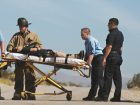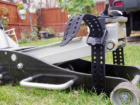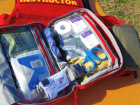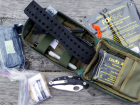
Features
“You only have minutes…” Why every officer needs an individual first aid kit
It’s hard to remember exactly what happened. There was a bright flash followed by a loud bang and somehow you ended up on the ground. You reach for the source of pain and are surprised to find blood seeping through your uniform. Thankfully, backup is right behind you, EMS is ten minutes away and the nearest fully equipped trauma room is 30 minutes down the road.
March 16, 2018 By Dave Brown
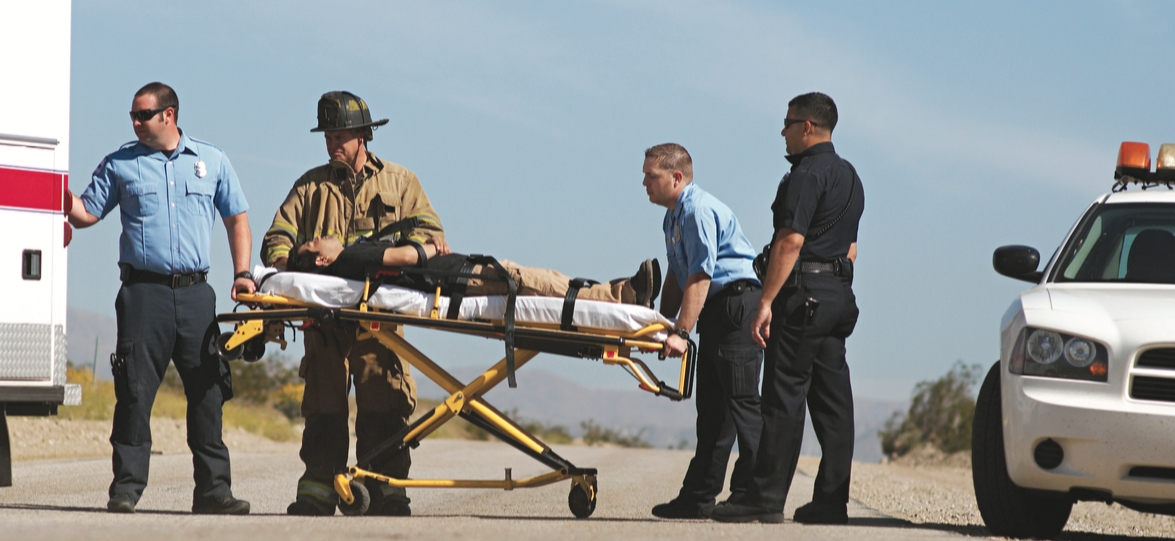
Unfortunately, if bleeding from a serious gunshot wound is not controlled right away, you could be dead in half that time.
These are the next few minutes of your life. What you did to prepare for this moment is going to dictate whether or not these are the last few minutes of your life.
Everyone who carries a firearm for a living or spends any amount of time on training ranges should seriously consider carrying an individual first aid kit (IFAK) in an easily accessible place on their person. An IFAK is not a general first aid kit, nor is it primarily designed to help others; it is for you, or for others around you, to help you.
The goal of a good IFAK should not be “how much can I stuff in there,” but rather, “what is the minimum amount of gear I need to keep me alive for those first few minutes.”
An IFAK is a minimal, singular-purpose kit designed to stop uncontrolled bleeding from a penetrating gunshot or stab wound. (This is why they are sometimes termed blow-out kits.) The philosophy of a compact IFAK that is carried with you at all times is simple — the most well-equipped first aid kit in your vehicle may be too far away when you need it the most.
During active shooter situations, people who can help may surround you, but if there is no tactical medic on your team, EMS may be forced to stay back until shooters have been neutralized and the zone cleared. Consider yourself on your own for the next few minutes.
Not every IFAK is going to be a perfect setup for everyone. As always, let your mission dictate your gear. The science of combat first aid has improved significantly in the past few years and officers can take advantage of this. A few carefully selected items can now be stored in a kit smaller than the size of a double AR magazine pouch.
What works
Tourniquets save lives. This lesson has been reinforced from decades of conflict in Iraq and Afghanistan to the streets of Boston, Las Vegas and even here in Canada. Lives have been saved by the quick application of a tourniquet to an extremity wound that would have otherwise resulted in the loss of consciousness within seconds, and death within minutes.
If there is one item in an IFAK that could be said to have advanced more than any other through the study of combat medicine and the science of casualty care, it would be the modern combat tourniquet.
Once considered a necessary part of every soldier’s kit, it was almost forgotten about for decades until the 1990s when a United States Special Operations medical research project was undertaken with the goal of improving trauma outcomes. Their research resulted in an article titled “Tactical Combat Casualty Care in Special Operations,” published as a supplement to the August 1996 issue of Military Medicine.
The project’s core principles for Tactical Combat Casualty Care (TCCC) are to avoid preventable deaths with effective gear, better training and good tactics. Their guidelines were customized primarily for use on the battlefield and concentrated on the three most common causes of preventable death in combat:
• extremity hemorrhage (60 per cent of deaths),
• tension pneumothorax (33 per cent of deaths), and
• airway obstruction (6 per cent of deaths).
The U.S. military began to equip every soldier on the ground with a compact first aid kit designed to address these three problems specifically. Those kits were designated as the “Improved First Aid Kit” in the U.S. Army, and the “Individual First Aid Kit” in the U.S. Air Force and U.S. Marines.
Those kits contained a variety of items depending on the issuing branch, designed for self-aid first and buddy-aid second. In other words, when carried in a place easily accessible to either hand, you would first use the kit on yourself, and if that were not possible, another soldier could use your kit on you.
In subsequent years, percentages of death due to tension pneumothorax have fallen significantly due to advances in body armour.
The same applies to police officers. Consider today that extremity hemorrhage will likely be your biggest concern. While combat soldiers may have to deal with hospital care that is hours away, police officers have sometimes been suddenly thrust onto streets that look more like combat zones and had to deal with situations where help is not always blocks away. This is why the lessons learned from combat are also important on the streets.
Equipment does not replace tactics and stopping the threat will always have first priority. The best medicine is superior firepower. That means winning the fight as quickly and efficiently as possible. After that, it’s time to look after the fallen.
What to carry
If you are selecting your own kit or in charge of outfitting others, you should have a good understanding of what works, and — almost as important — what you don’t need.
It may seem counter-intuitive, but experienced medics know what works and what to leave out. Unless your job is tactical or emergency medicine, they feel that one shouldn’t carry more than one can pack in one or two small pouches, and one shouldn’t carry anything that they are not trained to apply.
This greatly simplifies our selection process. Based on the fact that hemorrhage bleeding is the number one cause of preventable combat deaths, there are three main possibilities in those first few minutes: a gunshot wound to an extremity; a gunshot wound to the chest; or a gunshot wound that pierces an artery.
So while tension pneumothorax (a buildup of air from a sucking chest wound) is the next preventable cause of death on the battlefield, it probably won’t kill you in the first 30 minutes as much as uncontrolled bleeding will in two to three minutes. This is why most police officers in Canada can generally leave pneumothorax for EMS and worry primarily about stopping the rapid bleeding or sealing off a hole in the chest.
A minimal kit can therefore be as few as five basic items:
• nitrile gloves,
• tourniquet,
• pressure bandage,
• hemostatic gauze, and
• adhesive chest seal.
Add a means of cutting away clothing and maybe a pen to write down the time of application on the tourniquet, and you have your basic IFAK.
Gloves
Nitrile gloves are a necessity. Even if dealing with your own injuries, they will help pack gauze deep into a bullet wound. Tan or blue-coloured gloves are better than black because they show the presence of blood more clearly during a rapid body survey.
Tourniquets
A tourniquet should be the first thing you see when you open your IFAK. Applying direct or indirect pressure is the traditional first line of defence for a gunshot wound, but it may not always be practical to keep applying pressure to yourself or others if still under fire. Plus, if bleeding is serious you can lose consciousness quickly. If you are not sure, apply it.
High and tight are the keywords. They should be applied two finger widths proximal (toward the centre of the body) to the wound. If the tourniquet will be around a joint, apply it above the joint. It should be tight enough to stop the bleeding and when applied properly, you should not be able to stick three fingers under the strap.
The modern combat tourniquet is quick to apply, effective enough to stop the bleeding and wide enough to minimize the possibility of permanent damage — even if left on for hours. They also require minimal training.
Tourniquets will cause pain when applied, and even more pain when released but this is where proper training is important. Pain is not an indication it is on too tight or that nerve damage is occurring. Plus, a little pain is better than a lot dead.
Tourniquets should be left on until professional help arrives. They should not be loosened on a regular basis to restore circulation. Every time they are loosened, there is a risk of restarting bleeding — especially if it’s arterial — and that may not be stopped as easily the second time. If a second tourniquet is needed, apply it above the first one. Leave both on.
In my research, I have found three different levels of pre-hospital tourniquets:
• High quality combat-tested tourniquets such as Composite Resources Combat Applications Tourniquet (C-A-T), the Special Operations Forces Tactical Tourniquet Wide (SOF-TT W) and the SAM Extremity Tourniquet (SAM XT.) The C-A-T is slightly smaller and lighter, thanks to its composite rod versus the aluminum rod of the SOF-TT W. The SAM XT has a unique ratchet system that automatically locks when the correct tension is reached, and is very fast and simple to apply. All three are extremely well made. The C-A-T is now standard issue for Canadian troops.
• No-name knock off (or what I call “white label”) brands that copy the C-A-T design and are manufactured by medical supply houses in China. Primarily sold in volume by tender, there is no evidence that they may fail to work as designed.
• Imitation C-A-Ts designed for kids playing airsoft games. They are designed only for the look and should never be used in a real first aid kit.
Combat bandages
Pressure or “combat” bandages are designed to wrap tightly around a wound and apply the needed pressure to stop bleeding. They can be applied where a tourniquet is not appropriate. Stored in a highly-compressed state, they usually come in 4-inch and 6-inch widths. The best ones are the Israeli bandages (most of which are still made in Israel) and the modular Olaes bandage.
One 4-inch Israeli (commonly called an “Izzy”) or 4-inch flat-packed Olaes fits very nicely into my compact IFAK.
Pressure bandages are not designed to soak up blood for a serious or arterial wound; they are designed to apply pressure over top of tightly packed gauze in the wound. If a pressure bandage soaks through quickly, it is an indication that the wound was not packed tight enough and it should be removed and new gauze applied.
When you use gauze to pack a wound and a pressure bandage over top, keep the empty packet from the gauze and wrap it underneath the last two layers of the bandage so emergency room physicians know what you used.
Hemostatic gauze
Hemostatic products speed up the clotting of blood and this is where significant improvements have been made the past few years.
Original products came in a powder or crystal form that was sprinkled over the wound and then sealed or packed with gauze. The problem was that the early versions could cause severe burns through a chemical reaction.
Hemostatic agents have now been removed from most military IFAKs and replaced by the much better hemostatic-impregnated gauze. QuikClot Combat Gauze and Celox Rapid z-fold gauze are among the most well known products currently on the market.
QuikClot Combat Gauze is impregnated with kaolin, an inorganic mineral that accelerates the body’s natural clotting ability and produces no exothermic reaction. It works on contact with blood within seconds.
Celox uses a natural material called chitosan, a byproduct of shellfish. When chitosan contacts blood, it quickly swells and sticks together to form a gel seal. It does not generate heat, and any leftover material is easily absorbed by the body. Celox has also been extensively tested on people, many with shellfish allergies, with no ill effects ever reported.
Hemostatic gauze must be packed tight to the wound and must make contact with blood. If a wound must be repacked, it should be removed completely and new hemostatic gauze applied. If more gauze is needed to increase the pressure in the wound cavity, regular gauze may be packed over top of hemostatic gauze.
Chest seals
One place you do not need any holes — as if there were any place on your body that you do — is the chest. This includes from the belly-button area to the clavicle, on all four sides. A bullet hole here creates an opening where air being sucked in is just as likely to kill you as the bleeding. (This is why they are often referred to as a “sucking” wound.)
A chest seal is an adhesive plastic disk designed to stick to the skin and quickly seal up bullet holes. The best ones come in pairs, because if there is one hole in your chest, there is likely another. They use a very high adhesive seal that will effectively stick to hair, blood and wet skin. They must be licensed by Health Canada as a Class Two medical device. The two most popular ones are the Halo chest seal and the Fox seal, which is from the same maker as Celox.
The only downside to the seals is the awkward packaging sometimes means folding them before they fit in an IFAK.
What you don’t need
Many of the experts I talked to have seen valuable space in an officer’s IFAK taken up with unnecessary gear — everything from nasopharyngeal airways, chest decompression needles, and even scalpels.
Understand that you are not surrounded by combat soldiers who have all been trained in emergency first aid. You may be by yourself, or you may be surrounded by people with minimal or no training. For example, before anyone decides to put a chest needle into their kit, I always suggest they look around at the other people on the shooting range and decide for themselves if they want any of these folks jabbing long sharp instruments close to their heart.
Chest needles and airways are two items that are difficult for even the experts to apply and they usually aren’t something that needs to be done in the first few minutes, especially if you quickly occlude a chest wound with chest seals.
Vehicle kit
I spend a lot of time on shooting ranges, so I carry a second larger kit in my vehicle with more of the same items (plus others that are important but not necessarily critical):
• Five more pairs of nitrile gloves,
• Additional C-A-T tourniquet,
• Four-inch Olaes modular bandage,
• Six-inch Israeli compression bandage,
• QuikClot Combat Gauze,
• Two packs H&H compressed gauze,
• EMS shears,
• CPR mask,
• Twelve 4×4 gauze pads,
• Two cleansing and sanitizing towels,
• Two packs Water-Jel burn dressing,
• All-weather space blanket,
• Head-mounted LED light,
• Reflective traffic vest.
I am not a medic or a first aid expert. I trained in officer-down first aid and researched the top-quality products on the market today but what works for me isn’t going to work for everyone. The science of combat medicine is constantly evolving and new products are being introduced almost daily. I hope this gets you thinking about your IFAK and what you might need to save your life when you only have minutes after a gunshot wound.
Dave Brown is Blue Line’s firearms and police vehicle contributor. He is a tactical firearms trainer and consultant based in Winnipeg, Man. He can be reached at davebrown@blueline.ca.
Print this page
